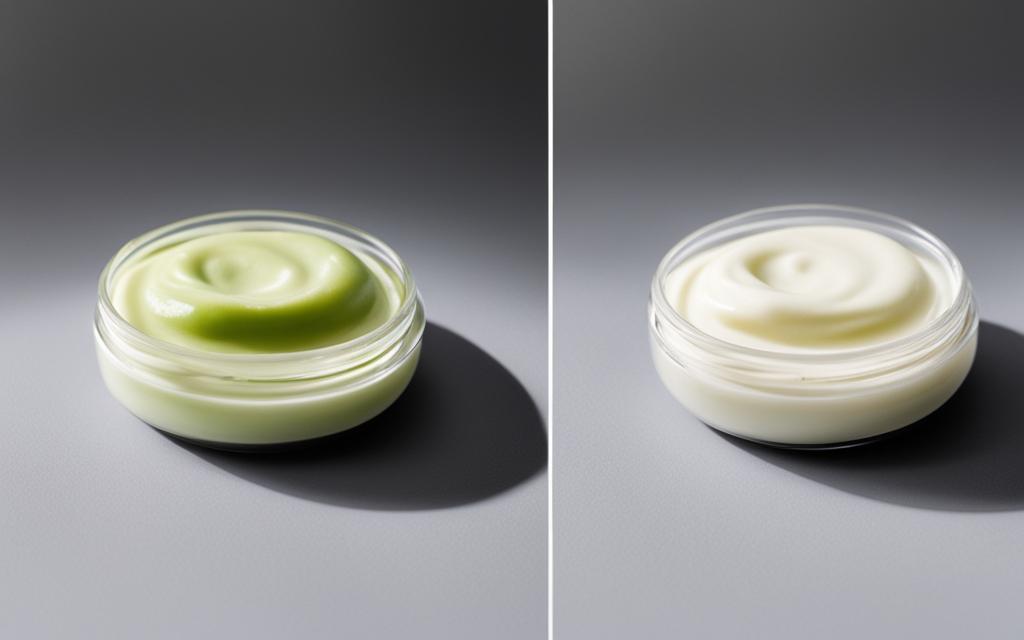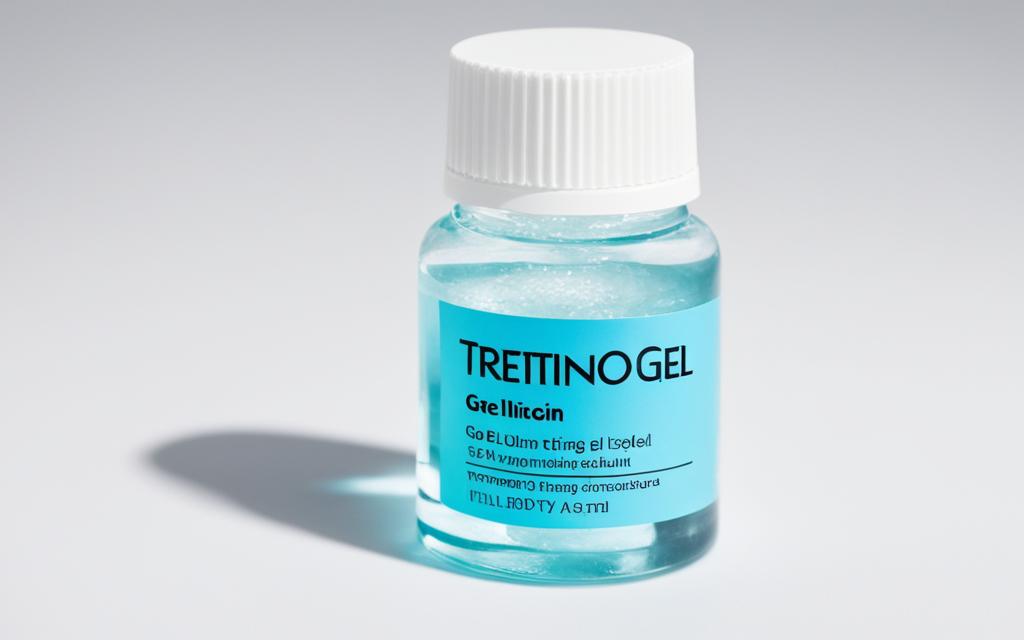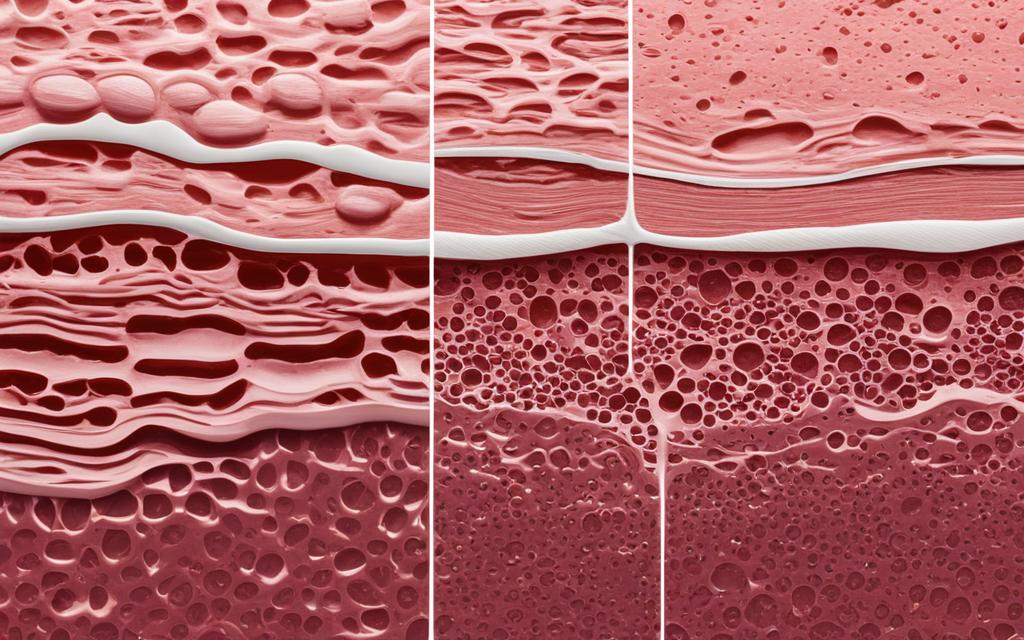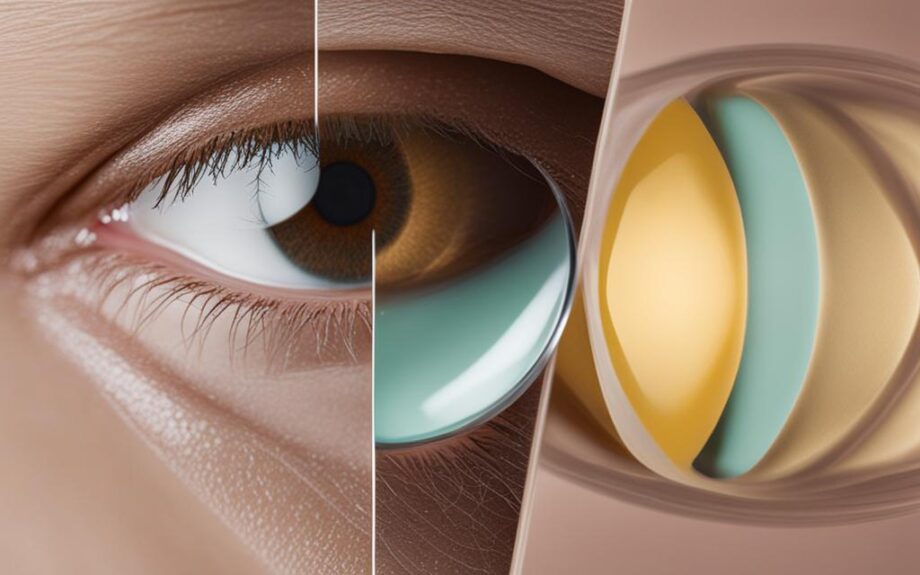If you’re new to tretinoin, you may be wondering whether you should use cream or gel formula. Both are effective in improving skin texture and addressing specific skin concerns, but each has unique benefits and considerations.
Tretinoin cream is a thicker, more emollient formula that is recommended for dry or sensitive skin. It is also effective in reducing fine lines and wrinkles, making it a popular choice for anti-aging regimens. Tretinoin gel, on the other hand, is a lighter and faster-absorbing formula that is recommended for oily or acne-prone skin.
Whether you go for cream or gel tretinoin, it’s important to consult with a skincare professional to determine which formulation best suits your skin type and individual needs.
Key Takeaways:
- Cream and gel formulations of tretinoin offer unique benefits and considerations.
- Cream is recommended for dry or sensitive skin and is effective in reducing fine lines and wrinkles.
- Gel is recommended for oily or acne-prone skin and is absorbed faster than cream.
- Consult with a skincare professional to determine which formulation is best for your skin type and individual needs.
Understanding Tretinoin Cream
When it comes to treating wrinkles and fine lines, tretinoin cream is a popular choice. The cream formulation is typically thicker and more moisturizing than tretinoin gel, which makes it a good option for individuals with dry or sensitive skin.
How to Apply Tretinoin Cream
Tretinoin cream should be applied to clean, dry skin at night. Begin by using a pea-sized amount and gently massage into the skin. Be sure to avoid the eyes, mouth, and any areas of broken skin. It is important to follow the usage instructions provided by your dermatologist or healthcare provider.
| Tretinoin Cream | Tretinoin Gel | |
|---|---|---|
| Texture | Thicker and more moisturizing | Lightweight and fast-absorbing |
| Application Method | Applied at night to clean, dry skin | Applied once or twice daily to clean, dry skin |
| Suitable Concerns | Wrinkles and fine lines | Acne and oily skin |
Potential Benefits of Tretinoin Cream
Tretinoin cream can help reduce the appearance of fine lines, wrinkles, and other signs of aging. It can also improve skin texture and tone by promoting new cell growth. Furthermore, tretinoin cream may have therapeutic effects on conditions such as melasma and post-inflammatory hyperpigmentation.
Considerations and Side Effects
Like all tretinoin formulations, tretinoin cream may cause mild to moderate irritation, redness, and peeling. It is important to use sunscreen and avoid excessive sun exposure while using tretinoin to reduce the risk of photosensitivity. Additionally, tretinoin cream should not be used during pregnancy or while breastfeeding.

In the next section, we will explore the properties of tretinoin gel and its suitability for addressing acne concerns.
Exploring Tretinoin Gel
When it comes to tretinoin, many people instantly think of the cream formulation. However, tretinoin gel offers its own unique advantages and benefits. For starters, the gel is typically lighter in texture and absorbs into the skin more quickly than the cream. This means it may be a better option for individuals with oily or acne-prone skin.
Benefits of Tretinoin Gel:
- Lighter, more easily absorbed texture
- Potentially more effective in addressing acne concerns
- May be a better option for individuals with oily skin
- Has potential anti-aging benefits
Unlike the cream, which is primarily used for reducing wrinkles and fine lines, tretinoin gel has been specifically formulated to address acne concerns. It works by reducing inflammation and unclogging pores, leading to fewer breakouts and clearer skin. Additionally, using tretinoin gel may also help reduce the appearance of acne scars over time.
Considerations and Side Effects:
| Considerations | Side Effects |
|---|---|
| May not be as suitable for dry or sensitive skin types | Skin dryness and peeling |
| Requires consistent use to see results | Skin redness and irritation |
| May increase sun sensitivity | Increased risk of skin damage if not used with proper SPF |
Tretinoin Cream or Gel for Anti-Aging?
While both tretinoin cream and gel have potential anti-aging benefits, they may be more effective on different skin types. For those with oilier skin, tretinoin gel may be the better option as it is lighter and more easily absorbed. Meanwhile, the cream formulation may be a better fit for individuals with dry or sensitive skin. Ultimately, it is important to consult with a skincare professional to determine which option is best suited for your unique needs and concerns.
Overall, tretinoin gel offers a potent solution for those looking to address acne concerns or achieve a more youthful appearance. However, as with any skincare product, it is important to use it properly and consistently while being mindful of any potential side effects.

Key Differences Between Cream and Gel Tretinoin
While both cream and gel formulations of tretinoin offer similar benefits, they differ in their texture, application method, and potential side effects. Here are some key differences to consider when choosing between the two:
- Absorption Rate: Tretinoin gel tends to be absorbed more quickly than cream, which may make it more suitable for individuals with oily skin.
- Skin Irritation: Tretinoin cream may cause more skin irritation, such as redness and peeling, than gel. This is due to the cream’s higher concentration of emollients and moisturizers.
- Anti-Aging Benefits: While both formulations can improve wrinkles and fine lines, tretinoin cream may be more effective due to its ability to hydrate and plump the skin.
- Suitability for Acne-Prone Skin: Tretinoin gel is typically the go-to choice for individuals with acne-prone skin due to its quick absorption and potential for reducing oiliness.
Ultimately, the choice between tretinoin cream and gel comes down to personal skin concerns and preferences. Consult with a dermatologist or skincare professional to determine which formulation is best suited for you.
Choosing the Right Tretinoin Formulation for You
Deciding on the right tretinoin formulation for your skincare needs can be an important consideration. We have outlined the benefits and considerations of tretinoin cream and tretinoin gel, but which one is right for you?
Firstly, consider your specific skin concerns. Are you looking to reduce the appearance of fine lines and wrinkles? Tretinoin cream might be the best option for you. However, if you are dealing with acne concerns, tretinoin gel may be more suitable.
Another important consideration is your tolerance to potential side effects. Tretinoin cream may be more likely to cause skin irritation, redness, and dryness compared to tretinoin gel. If you have sensitive skin or have experienced irritation in the past, you may want to consider tretinoin gel.
Personal preference also plays a role in this decision. Consider factors such as texture and application method. Tretinoin cream has a thicker texture which may be more hydrating for some individuals. Tretinoin gel, on the other hand, dries quickly and can be used under makeup.
Comparison of Tretinoin Cream and Gel
| Tretinoin Cream | Tretinoin Gel | |
|---|---|---|
| Texture | Thick and hydrating | Lightweight and dries quickly |
| Application Method | Applied in a pea-sized amount and massaged into the skin | Applied in a pea-sized amount and left to dry before moisturizer or makeup |
| Potential Benefits | Reduces the appearance of fine lines and wrinkles | Helps address acne and clogged pores |
| Considerations | Potential for skin irritation, redness, and dryness | Dries quickly and may cause minimal irritation |
By evaluating these aspects, you can confidently choose between tretinoin cream and gel. Remember, it’s important to consult with a dermatologist or skincare professional before incorporating tretinoin into your skincare routine.

Conclusion
In conclusion, choosing between tretinoin cream and gel ultimately depends on your specific skincare needs and preferences. Both formulations offer unique benefits, with tretinoin cream being an excellent choice for reducing wrinkles and fine lines, and tretinoin gel being highly effective in addressing acne concerns.
Additionally, both cream and gel formulations have the potential to improve skin texture and overall appearance, making them powerful tools for an anti-aging skincare routine. However, it is important to consult with a dermatologist or skincare professional to determine which formulation is best suited for your individual needs and skin type, as tretinoin can have potential side effects such as skin irritation or sensitivity.
By incorporating tretinoin into your skincare routine, you can achieve a smoother, clearer, and more youthful-looking complexion. Whether you choose to use tretinoin cream or gel, be sure to follow the application instructions carefully and consistently for the best results.
Thank you for reading our guide on cream vs gel tretinoin. We hope this has helped you make an informed decision about which formulation is right for you and your skincare goals.
FAQ
What is the difference between tretinoin cream and gel?
Tretinoin cream and gel are two different formulations of the same active ingredient. The main difference lies in the texture and base of the product. Creams are usually oil-based, providing a moisturizing effect, while gels are water-based and have a lighter texture. The choice between the two depends on individual preferences, skin type, and specific skincare concerns.
Which is better, tretinoin cream or gel?
The effectiveness of tretinoin cream and gel depends on individual factors and skincare needs. Creams are generally recommended for dry or sensitive skin, as they provide more hydration. Gels, on the other hand, are often preferred for oily or acne-prone skin due to their lighter texture and potential drying effect. It is best to consult with a dermatologist to determine the most suitable formulation for you.
Are there any specific benefits of tretinoin cream for wrinkles?
Tretinoin cream is known for its ability to reduce the appearance of wrinkles and fine lines. It works by increasing the turnover of skin cells and stimulating collagen production, which can result in smoother and more youthful-looking skin. However, it is important to note that tretinoin cream may cause initial redness, dryness, and peeling, so it is recommended to start with a lower concentration and gradually increase as tolerated.
Can tretinoin gel be used for acne?
Yes, tretinoin gel is commonly used to treat acne. Its unique formulation penetrates the skin more effectively, making it suitable for targeting acne-causing bacteria and reducing clogged pores. Tretinoin gel can help to unclog pores, reduce inflammation, and promote skin cell turnover, which can improve the appearance of acne and prevent future breakouts.
What are the benefits of both tretinoin cream and gel for anti-aging?
Both tretinoin cream and gel have anti-aging benefits. They can help improve skin texture, reduce the appearance of fine lines and wrinkles, and enhance overall skin radiance. Tretinoin stimulates collagen production, which can improve skin elasticity and firmness. For optimum results, it is recommended to use tretinoin under the guidance of a dermatologist and incorporate it into a comprehensive skincare routine.
How do I choose the right tretinoin formulation for my skincare needs?
Choosing the right tretinoin formulation depends on various factors, including your skin type, specific concerns, and any existing skin conditions. If you have dry or sensitive skin, tretinoin cream may be a better option due to its moisturizing properties. If you have oily or acne-prone skin, tretinoin gel may be more suitable. Consulting with a dermatologist will help determine the best formulation and concentration for your individual needs.
